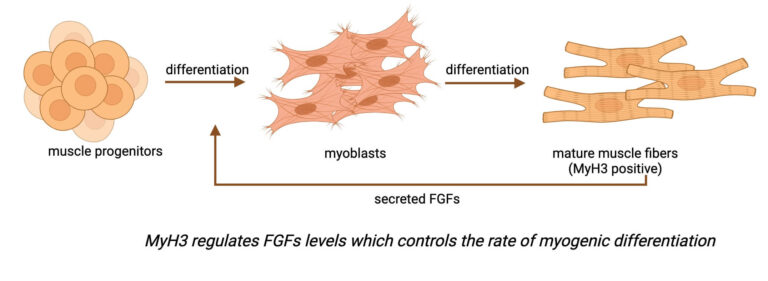MyH3: A key player in skeletal muscle development
Work done in the lab of Dr. Sam J Mathew at Regional Centre for Biotechnology, Faridabad, India.
Dr. Megha Agarwal is a postdoctoral scholar at the School of Medicine, Stanford University in the division of Pediatrics Cardiology. She has a BVSC & AH from Govind Ballabh Pant University of Agriculture and Technology, India, and an MVSC degree in Animal Biotechnology from Indian Veterinary Research Institute, India. She did her PhD in Developmental Genetics from UNESCO- Regional Centre for Biotechnology, India under the mentorship of Dr. Sam J Mathew. She has a pre-doctoral experience of a year as a research scientist working for a non-profit organization. She has received several honors/awards and has nearly 10 peer-reviewed publications to her name where one of her works is highlighted as a “research journey interview” in the journal “Development”. Besides publications, she has reviewed more than 10 manuscripts for some reputed journals.
Author Interview
How would you explain your research outcomes to the non-scientific community?
Vertebrate muscle is important for mobility, posture, support, and maintenance of body temperature. The skeletal muscle myosin heavy chain (MyHC) gene family is critical to skeletal and heart muscle structure and function. MyHCs have been reported to cause skeletal muscle and heart defects such as myopathies, cardiomyopathies, and congenital muscle diseases like Freeman-Sheldon syndrome, however, the precise molecular mechanisms underlying these diseases are unclear, thus limiting diagnosis and treatment options. The specific question we ask here is what is the role of MyH3 during mammalian skeletal muscle development? Our data shows that MyH3 performs novel cell-autonomous and non-cell-autonomous functions during myogenesis. At the cell-autonomous level, MyH3 regulates muscle fiber size, fiber number, and fiber type, whereas at the non-cell-autonomous level, it regulates myogenic progenitor and myoblast differentiation. Next, we ask how it performs these functions? MyH3 mediates non-cell-autonomous effects via secreted fibroblast growth factor (FGF) signaling as supplementation with FGF in the culture media rescues the myogenic differentiation defects caused by loss of MyH3 function in vitro. Overall, our results have identified MyH3 as a crucial regulator of mammalian myogenesis during development.

“In this paper, we answer how a mutation in the MyH3 gene leads to a disease phenotype.”
How do these findings contribute to your research area?
Around twenty-six missense mutations in MyH3 have been associated with disease phenotype but the exact mechanism was unknown. In this paper, we answer how a mutation in the MyH3 gene leads to a disease phenotype. These findings have explained that the developmental structural protein MyH3 regulates myogenic progenitor and myoblast pool during differentiation and development. Another important aspect the study revealed, is the mechanism of how MyH3 regulates myogenesis- MyH3 within myofibers during embryonic and fetal stages is required to regulate FGF levels, which control the rate of differentiation of myogenic progenitors and myoblasts into myofibers.
What was the exciting moment during your research?
I would say that the most exciting moment was when I successfully figured out, by mass spectrometric analysis, that secreted FGF levels are altered upon knockdown of MyH3. This led us to the mechanism of how MyH3 regulates muscle differentiation non-cell-autonomously, confirming and validating our hypothesis.
What do you hope to do next?
Here, we have focused on the role of MyH3 during development. We believe that MyH3 might also play a distinct role in adult myogenesis and my colleagues in the lab are investigating its role in adult muscle regeneration. Also, future work on how the observed phenotypic changes contribute to scoliosis would shed light on the role of MyH3 in congenital contracture syndromes.
Where do you seek scientific inspiration from?
My interest in sciences was instilled in me by my animal physiology professor when they first showed me blood cells under a microscope. During my master’s degree, I worked on stem cells, and I was so fascinated by how smart these cells are. How stem cells serve as a maintenance and repair resource for the entire body is something that excited me. I am thankful to have amazing mentors throughout my scientific journey.
How do you intend to help Indian science improve?
After my post-doctoral studies, I plan to be an independent investigator and open my lab in India.
Reference: Agarwal M, Sharma A, Kumar P, Kumar A, Bharadwaj A, Saini M, Kardon G, Mathew SJ. Myosin heavy chain-embryonic regulates skeletal muscle differentiation during mammalian development. Development. 2020 Apr 6;147(7):dev184507. doi: 10.1242/dev.184507. PMID: 32094117; PMCID: PMC7157585. https://journals.biologists.com/dev/article/147/7/dev184507/223093/Myosin-heavy-chain-embryonic-regulates-skeletal
Edited by: Ritvi Shah
Biopatrika: Bringing Science to Society
© Biopatrika 2023 All Rights Reserved.

